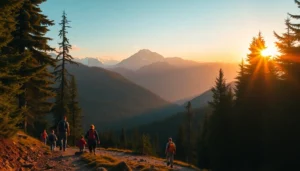Master the Art of Hiking: Tips and Trails to Elevate Your Adventure in Indonesia

Introduction to Hiking in Indonesia
Indonesia, renowned for its lush landscapes, towering volcanoes, and diverse ecosystems, is a paradise for hiking enthusiasts. From the rugged terrains of Sumatra to the serene trails of Bali, Indonesian hiking destinations offer unparalleled adventure, natural beauty, and cultural immersion. Whether you’re a seasoned trekker or a casual outdoor lover, exploring Indonesia’s trails provides a unique opportunity to connect with nature, challenge yourself, and discover hidden gems. If you’re seeking to truly engage with the wilderness, understanding the nuances of hike in Indonesia can elevate your experience, ensuring safety, enjoyment, and meaningful encounters along the way.
What Defines a Memorable Hike
A memorable hike is an experience that combines scenic beauty, physical challenge, cultural richness, and personal growth. In Indonesia, such hikes often feature breathtaking vistas of volcanic craters, tropical rainforests, waterfalls, and encounters with indigenous communities. The essence of a memorable hike lies in its ability to stir emotional and sensory responses—standing atop a mountain at sunrise, hearing the symphony of jungle sounds, or simply breathing in the fresh, unspoiled air. Key aspects that define an unforgettable hike include:
- Scenic Diversity: From panoramic mountain views to tranquil beaches.
- Trail Challenge: Ranging from easy walks to strenuous ascents suitable for different fitness levels.
- Cultural Engagement: Opportunities to interact with local tribes or visit traditional villages.
- Personal Achievement: Overcoming obstacles, reaching new heights, and gaining a sense of accomplishment.
Creating lasting memories also involves thoughtful planning, engaging in mindfulness during the trek, and embracing the spontaneous moments that make each hike unique.
The Health and Wellness Benefits of Hiking
Hiking is not merely an outdoor activity; it is a comprehensive approach to improving physical and mental health. Indonesia’s diverse terrain offers perfect settings for various health benefits:
Physical Fitness Enhancement
Regular hiking contributes to cardiovascular health, muscular strength, and flexibility. Conquering steep inclines and rocky paths engages different muscle groups, promoting overall physical resilience. Studies indicate that consistent walking on varied terrains can reduce risks associated with heart disease, obesity, and hypertension.
Mental and Emotional Well-being
Immersing oneself in nature reduces stress, anxiety, and symptoms of depression. The therapeutic effects of green environments and fresh air have been well-documented. In Indonesia, the tranquil settings of rice terraces or jungle trails offer mental clarity and a sense of peace, crucial for mental health maintenance.
Social Connection and Community Building
Group hikes foster social bonds, cultural exchange, and communal purpose. Joining local or international hiking groups in Indonesia creates opportunities for shared experiences, language learning, and mutual encouragement.
Longevity and Quality of Life
Active lifestyles, complemented by outdoor adventures like hiking, have been linked to increased lifespan and improved quality of life in seniors as well as younger populations.
Embracing hiking as a routine or seasonal activity can significantly enhance overall well-being—both physically and psychologically—making it an invaluable component of a healthy lifestyle.
Popular Hiking Destinations in Lombok and Beyond
Indonesia features a plethora of iconic trails, many of which are accessible from Lombok, a crown jewel of natural beauty and adventure. Here, we explore some top hiking destinations across Lombok and other regions that promise extraordinary experiences:
Lombok: The Land of Active Volcanoes and Hidden Trails
Lombok is home to rugged mountains and pristine beaches, making it a premier hiking location. The island’s crown jewel is Mount Rinjani, the second-highest volcano in Indonesia, standing at 3,726 meters. A trek to Rinjani’s crater lake, Segara Anak, offers breathtaking views, geothermal activity, and a sense of achievement. The trail encompasses several difficulty levels, from challenging multi-day hikes to easier day treks around Mount Rinjani’s foothills.
Mount Rinjani National Park
Beyond Rinjani itself, the national park features lush forests, waterfalls such as Sendang Gile and Tiu Kelep, and diverse flora and fauna. The park’s trails provide immersive experiences in Indonesia’s biodiversity.
Bali: Trekking the Sacred Volcanoes and Rice Terraces
While renowned for its beaches and temples, Bali also offers exhilarating treks. The sunrise hike up Mount Batur is famous for panoramic vistas. Exploring the Jatiluwih rice terraces or ascending Mount Agung provides both scenic beauty and cultural insights.
Other Noteworthy Trails
- Ijen Crater, Java: Witness the surreal blue flames and sulfur lakes atop a volcanic caldera.
- Bromo Tengger Semeru National Park, Java: Iconic sunrise views over volcanic landscapes.
- Komodo Island: Trek through the islands’ rocky terrains to spot the legendary Komodo dragons.
Each destination presents unique challenges and rewards, enabling hikers to select trails that match their skill levels and interests while discovering Indonesia’s multifaceted natural tapestry.
Essential Planning for a Successful Hike
Choosing the Right Trail and Difficulty Level
Proper trail selection is paramount to ensuring an enjoyable and safe experience. Assess your fitness, experience, and interests to match with a trail that offers the right challenge. Resources such as local guides, online trail maps, and hikers’ reviews can aid in decision-making. For beginners, easy routes around lush forests or coastal paths may suffice, while experienced hikers may venture into technical mountain climbs or multi-day expeditions.
Gear and Clothing Tips for Comfort and Safety
Appropriate gear drastically improves comfort and reduces hazards. Essential items include:
- Footwear: Durable, waterproof hiking boots or shoes with good traction.
- Clothing: Moisture-wicking base layers, layered clothing for variable weather, and sun protection such as hats and sunglasses.
- Backpack: Lightweight but spacious, equipped with hydration bladder or water bottles.
- Navigation tools: Maps, GPS devices, or compasses—especially for remote trails.
- Safety Equipment: First aid kit, multi-tool, flashlight, and whistle.
Investing in quality gear often yields safety benefits and enhances the overall experience, making even challenging terrains manageable.
Navigating Weather and Environmental Factors
Indonesia’s tropical climate necessitates attentiveness to weather conditions. Heavy rain can cause trail erosion or landslides, while high temperatures require hydration and sun protection. Always check weather forecasts prior to your hike, and carry rain gear or sunblock accordingly. During the rainy season (November to March), some trails may be risky or inaccessible; planning accordingly ensures safety.
Hiking Techniques and Best Practices
Proper Walking and Trekking Posture
Maintaining correct posture reduces fatigue and injury risk. Keep your back straight, shoulders relaxed, and look ahead rather than down at your feet. Use your arms to balance, especially on uneven terrain, and take deliberate, steady steps to conserve energy.
Maintaining Stamina and Hydration
Energy management is critical. Eat high-energy snacks such as nuts, dried fruit, or energy bars regularly. Hydrate consistently, aiming for at least 2 liters of water daily—more in hot and humid environments. Rest periodically to recover and prevent overexertion. Implementing pacing strategies tailored to your fitness level ensures endurance throughout the hike.
Leave No Trace: Eco-Friendly Hiking Habits
Respect for nature and local communities enhances sustainability. Follow Leave No Trace principles: pack out all trash, stay on established trails, avoid disturbing wildlife, and minimize campfire impacts. Supporting local conservation initiatives and engaging with indigenous guides fosters responsible tourism and preserves Indonesia’s natural heritage.
Advanced Hiking Skills and Safety
Handling Emergencies and First Aid
Preparedness for accidents or health issues is vital. Basic first aid knowledge—treating cuts, sprains, or insect bites—can be life-saving. Carry a compact first aid kit and know how to use its contents. For remote hikes, consider carrying a satellite phone or emergency beacon.
Using Navigation Tools and Maps Effectively
Beyond GPS, understanding topographic maps and compass use enhances navigation accuracy. Practice celestial navigation or landmark identification for challenging situations. Familiarity with local signage and terrain features reduces the risk of getting lost.
Trail Conservation and Supporting Local Communities
Contributing to the preservation of trails involves staying on designated paths, avoiding littering, and respecting local customs. Purchasing supplies locally, engaging with community-led tours, and contributing to conservation projects promote sustainable tourism and benefit host communities economically and culturally.
Enhancing Your Hiking Experience
Integrating Photography and Journaling
Documenting your journey through photography captures the essence of each trail—vivid sunsets, unique flora, traditional villages—and allows for reflection and sharing. Carry lightweight cameras or smartphones with ample storage. Journaling during or after the hike helps process the experience, deepen appreciation, and preserve memories for years to come.
Connecting With Fellow Hikers and Outdoor Groups
Joining local or international hiking communities fosters camaraderie, exchange of tips, and cultural learning. Many Indonesian regions host outdoor clubs, guided tours, and online forums that facilitate meetings, group hikes, and knowledge sharing.
Planning Multi-Day Hikes and Camping Experiences
Extending your hike across multiple days amplifies adventure and immersion. Prep includes packing lightweight camping gear, planning routes with designated campsites, and respecting environmental regulations. In Indonesia, many trails accommodate rustic camping, where you can enjoy starry nights and sense of wilderness. Ensure your plan includes contingency options such as rescue contacts and weather buffers.




